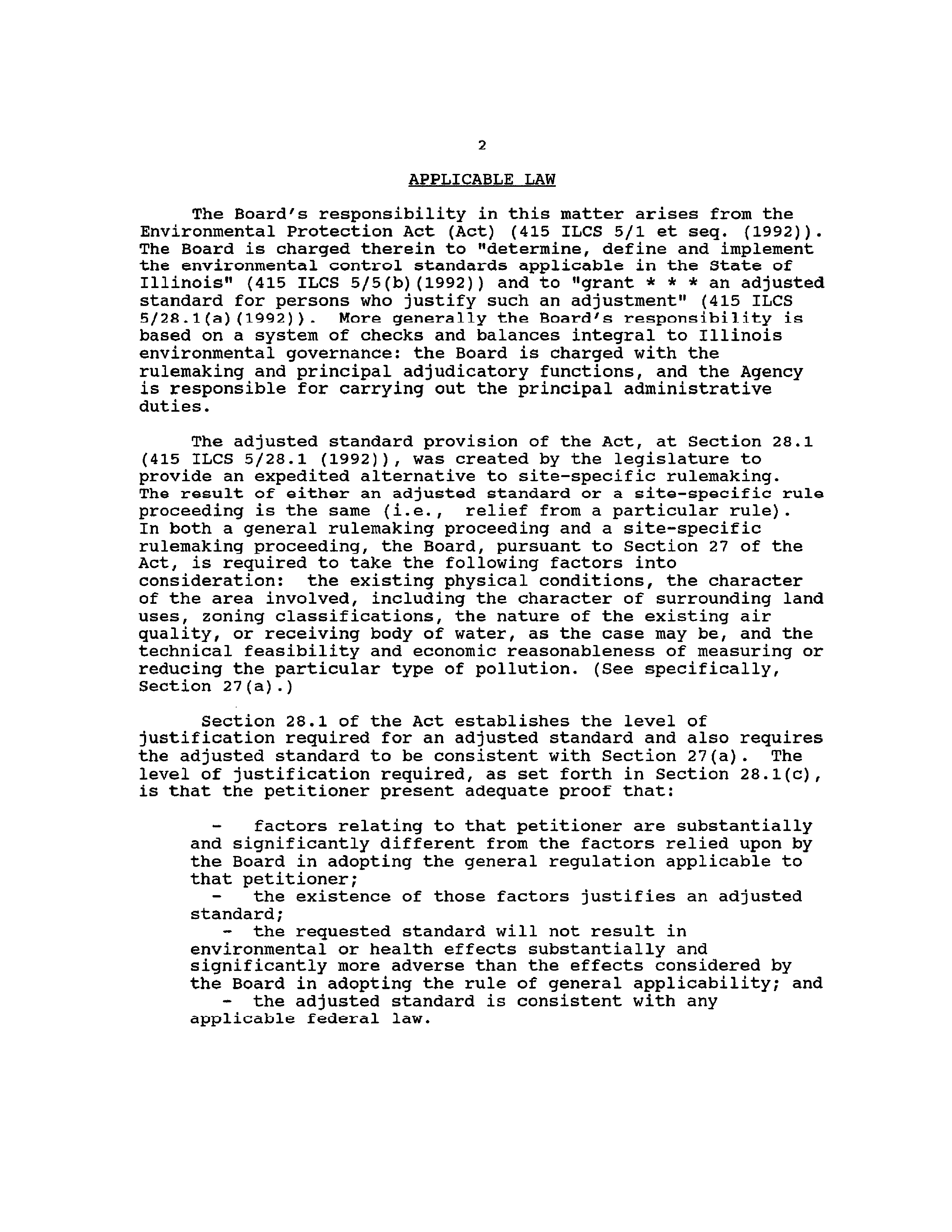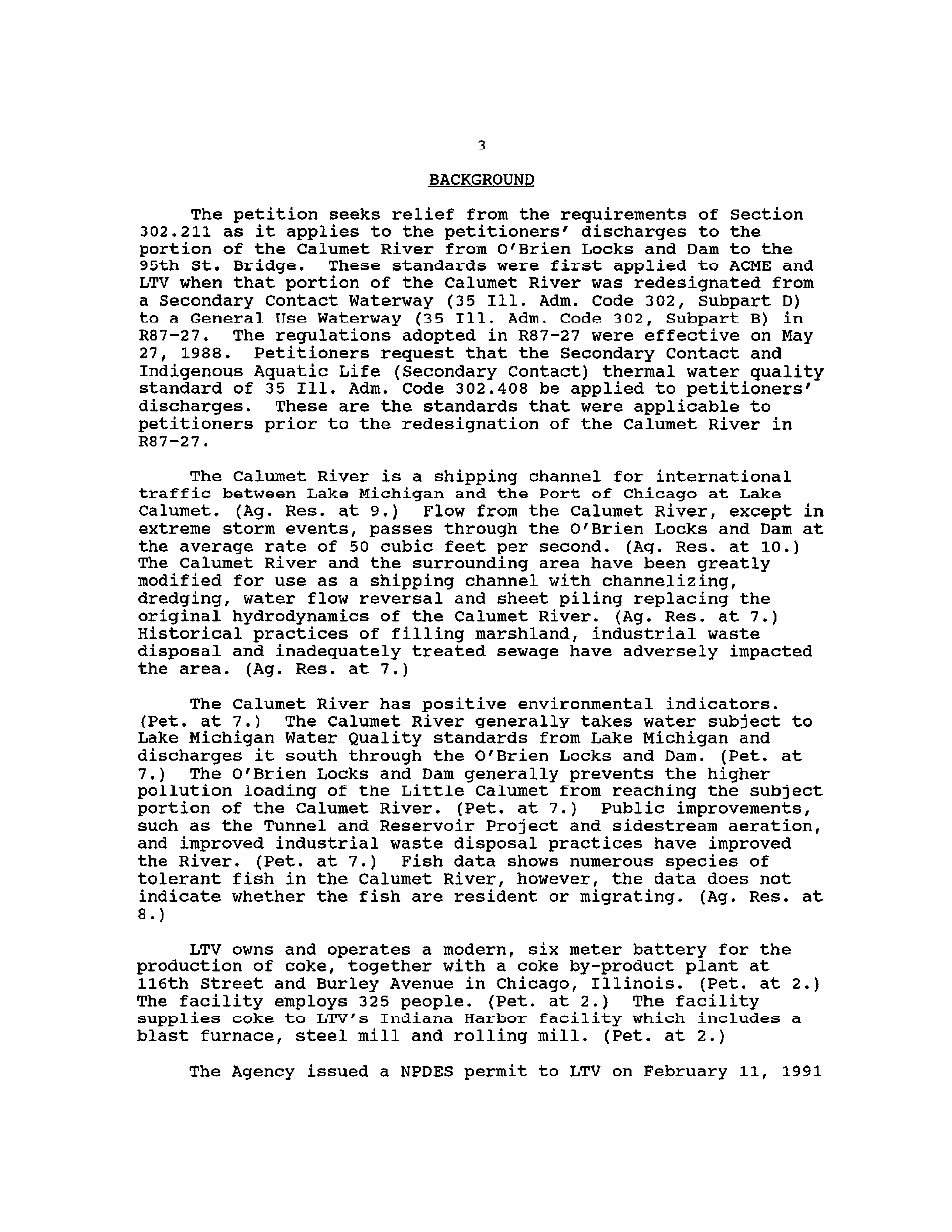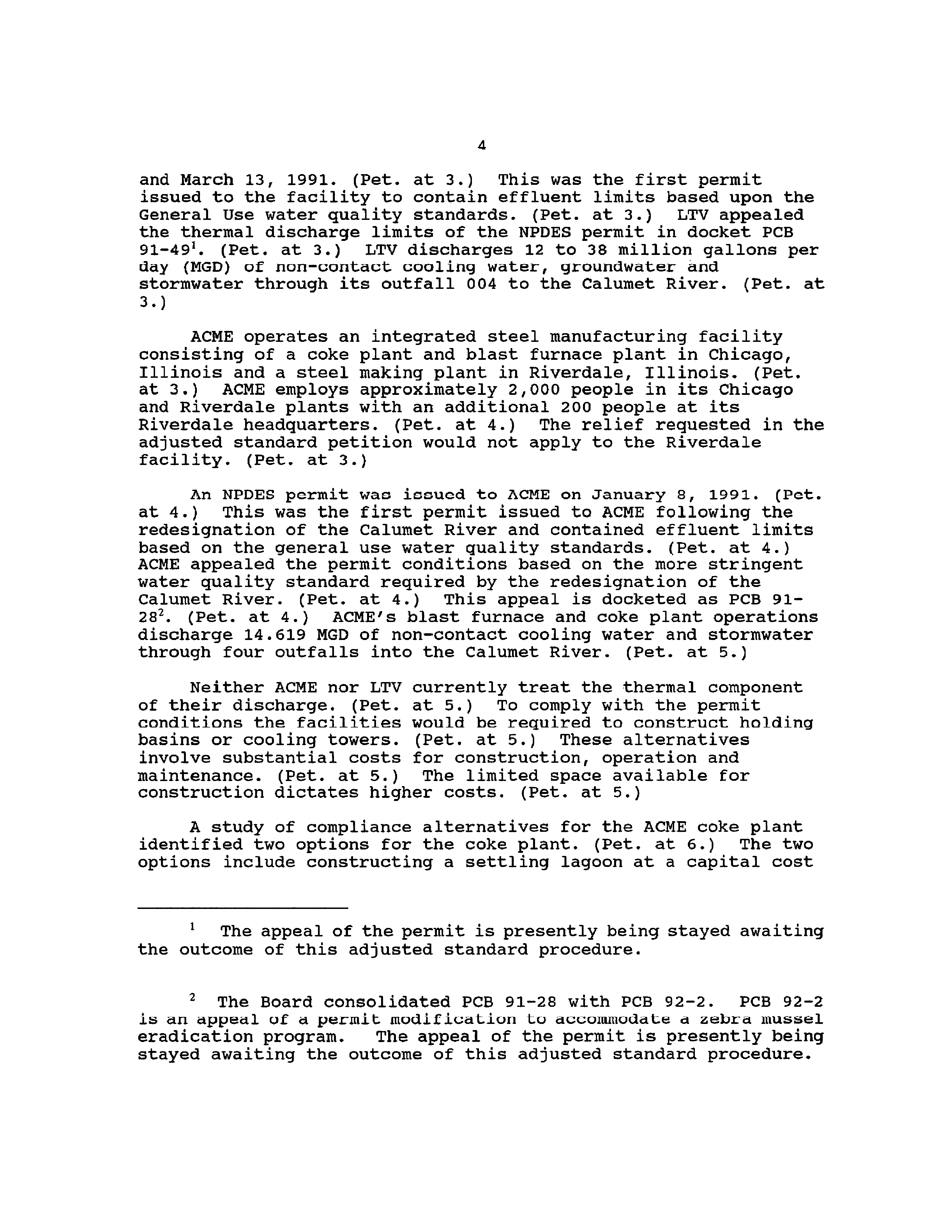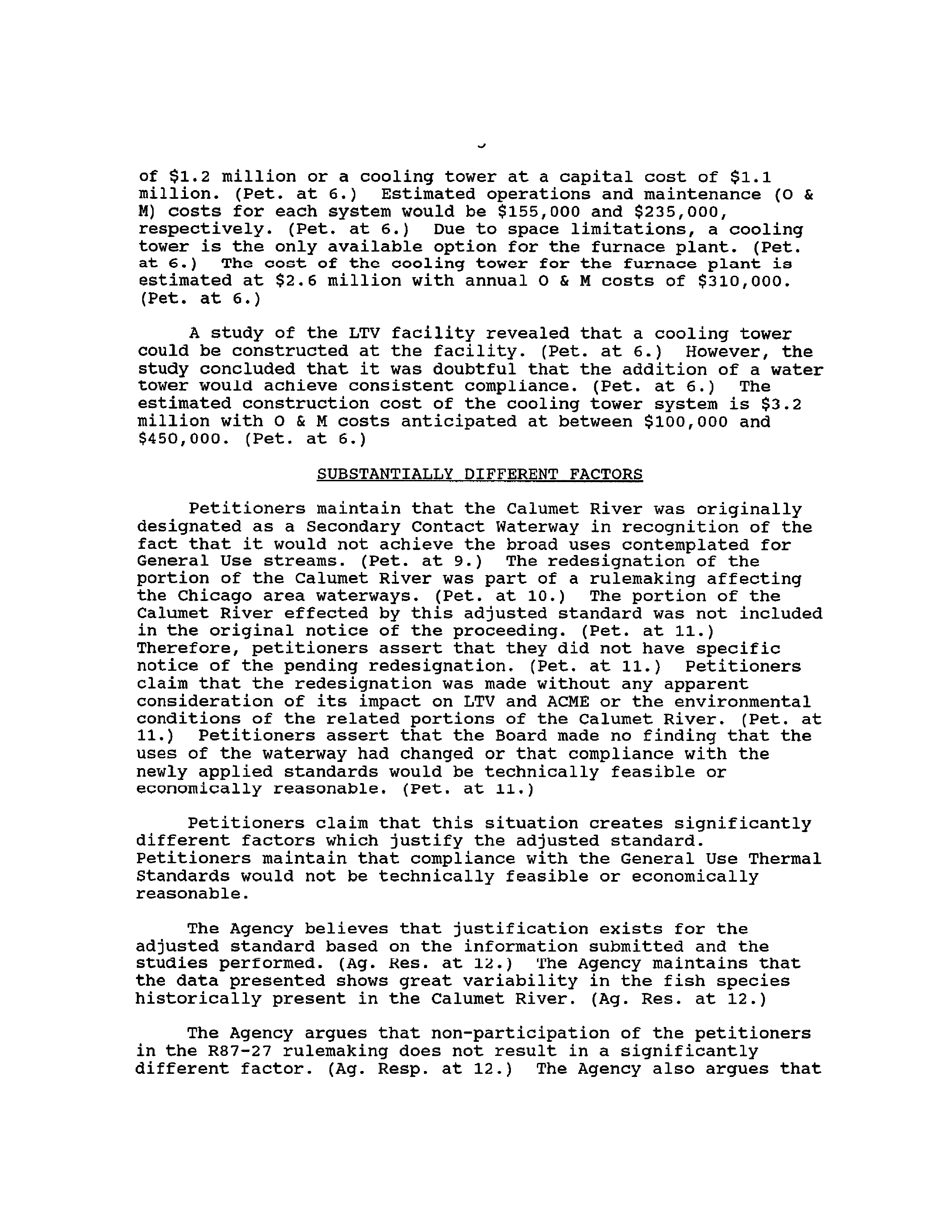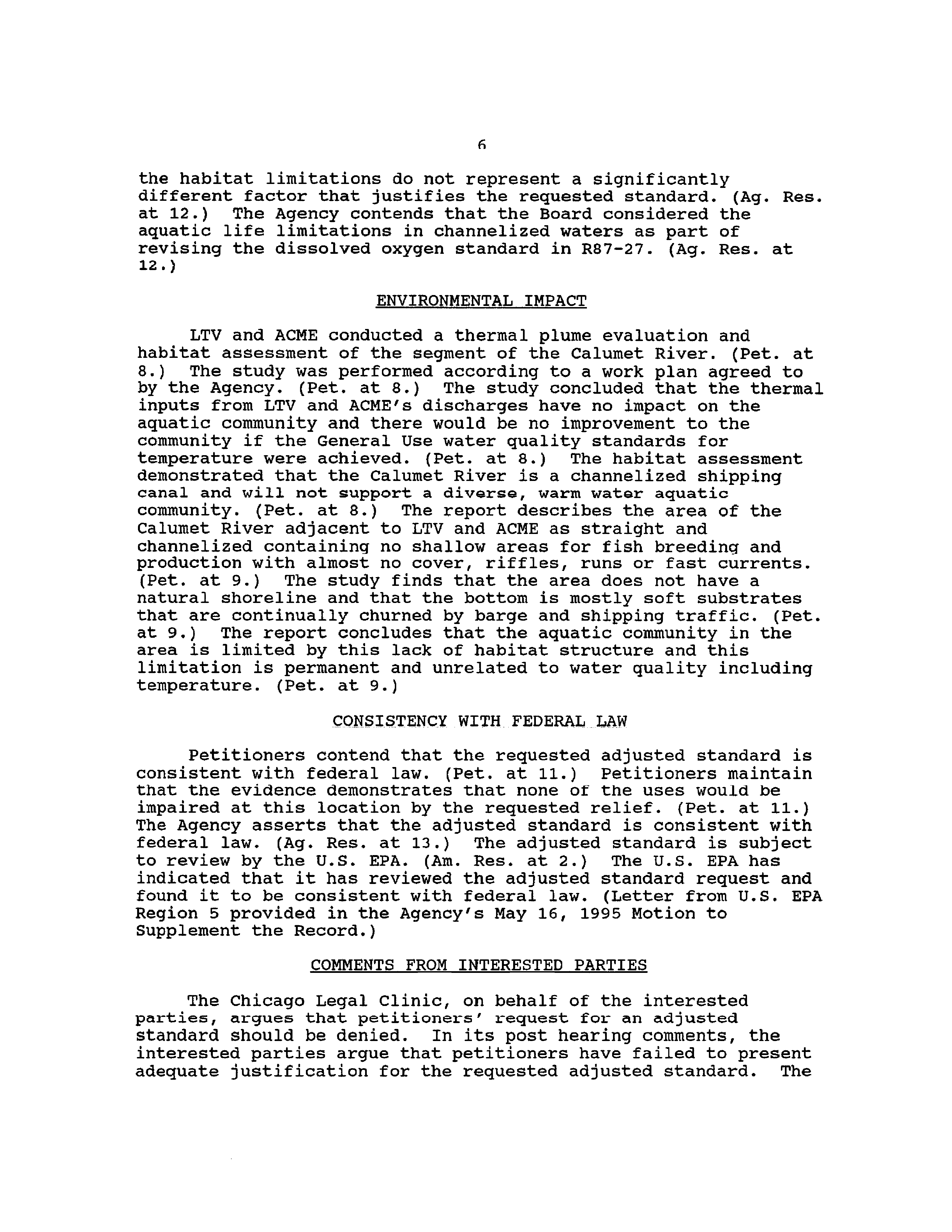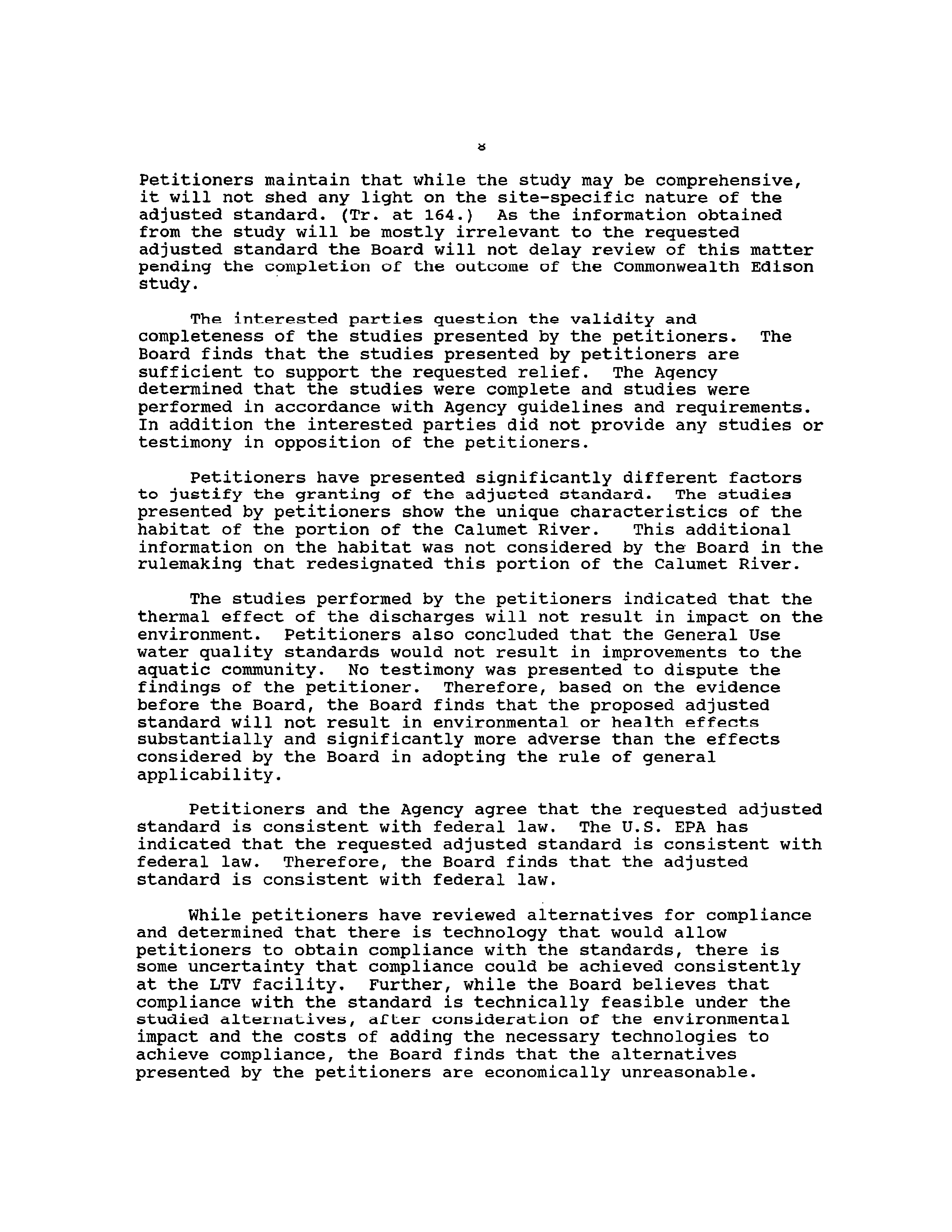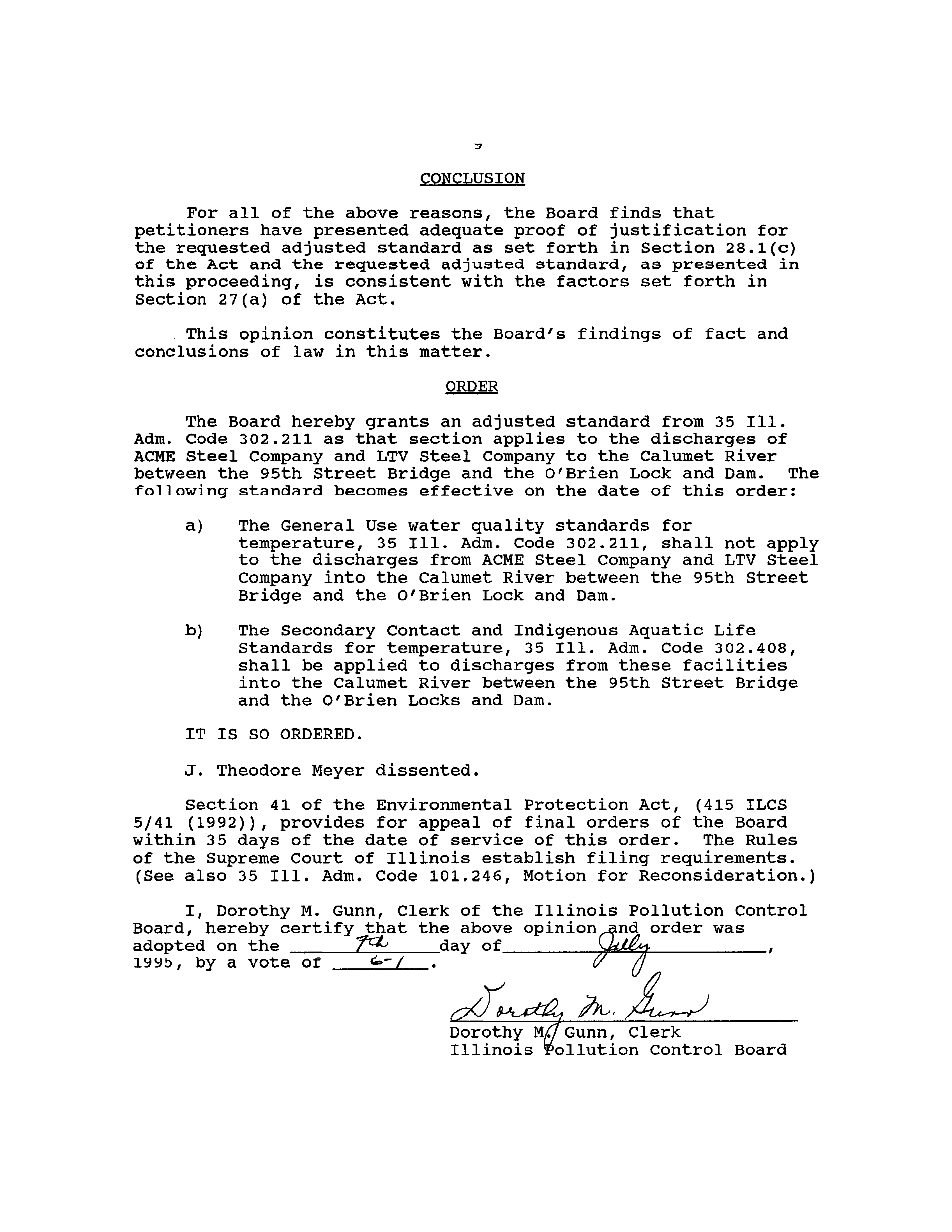ILLINOIS POLLUTION CONTROL BOARD
July 7,
1995
IN THE MATTER OF:
)
PETITION OF ACME STEEL COMPANY
)
AS 94-8
AND
LTV STEEL COMPANY FROM
)
(Adjusted Standard-Water/NPDES)
35 ILL. ADM. CODE 302.211
)
DAVID L.
RIESER OF ROSS & HARDIES APPEARED ON BEHALF OF ACME
STEEL COMPANY AND LTV STEEL COMPANY;
RICHARD
C. WARRINGTON, JR. APPEARED ON BEHALF OF THE ILLINOIS
ENVIRONMENTAL PROTECTION AGENCY;
ANNA B. TRISTAN OF THE CHICAGO LEGAL CLINIC APPEARED ON BEHALF OF
INTERESTED PARTIES.
OPINION AND ORDER OF THE BOARD
(by E. Dunham):
This matter comes before the Board on a petition for
adjusted standard from 35 Ill. Adm. Code 302.211 filed on March
24, 1994 by ACME Steel Company and LTV Steel Company.
On August
8,
1994, petitioners filed an amended petition seeking an
adjusted standard for a period of five years.
The petitioners
also requested additional time to file additional information.
On February 23, 1995 petitioners filed an amended petition
seeking permanent relief instead of an adjusted standard for five
years.
The Illinois Environmental Protection Agency’s (Agency)
response to the petition was filed on November 28,
1994
recommending that the adjusted standard be granted for a period
of five years and that petitioners be required to perform
additional studies to support permanent relief.
On March 23,
1995 the Agency filed an amended response in support of permanent
relief based on additional information provided by the
petitioners.
On April 20,
1994,
the Board received a letter from the
Chicago Legal Clinic on behalf of Marian Byrnes of the Southeast
Environmental Task Force, Clem Balanoff,
Frank Rusdorf and Jo
Troncozo (interested parties) requesting that a hearing be held
in this matter.
A hearing on the petition was held on April
10,
1995 before hearing officer June Edvenson in Chicago,
Illinois.
Petitioners filed a post—hearing brief on May 15,
1995.
Post—
hearing comments from the interested parties were filed on May
15, 1995.
The Agency filed its post—hearing comment on May 16,
1995.
Petitioners filed a reply to the post-hearing comments on
May 25,
1995.
The Agency filed a motion to supplement the record on May
16, 1995.
The Agency requests to supplement the record with a
letter from the U.S. EPA stating that the proposed adjusted
standard is consistent with federal law.
The Board grants the
Agency’s motion to supplement the record.
2
APPLICABLE
LAW
The Board’s responsibility in this matter arises from the
Environmental Protection Act (Act)
(415 ILCS 5/1 et seq.
(1992)).
The Board is charged therein to “determine, define and implement
the environmental control standards applicable in the State of
Illinois”
(415 ILCS 5/5(b) (1992))
and to “grant
*
*
*
an adjusted
standard for persons who justify such an adjustment”
(415 ILCS
S/28.1(a)(1992)).
More generally the Enard’s responsibility
is
based on a system of checks and balances integral to Illinois
environmental governance: the Board is charged with the
rulemaking and principal adjudicatory functions, and the Agency
is responsible for carrying out the principal administrative
duties.
The adjusted standard provision of the Act,
at Section 28.1
(415 ILCS 5/28.1
(1992)), was created by the legislature to
provide an expedited alternative to site-specific rulemaking.
The result of either an adjusted standard or
a site—specific rule
proceeding is the same
(i.e.,
relief from a particular rule).
In both a general rulemaking proceeding and a site—specific
rulemaking proceeding, the Board, pursuant to Section 27 of the
Act,
is required to take the following factors into
consideration:
the existing physical conditions, the character
of the area involved, including the character of surrounding land
uses,
zoning classifications, the nature of the existing air
quality,
or receiving body of water,
as the case may be, and the
technical feasibility and economic reasonableness of measuring or
reducing the particular type of pollution.
(See specifically,
Section 27(a).)
Section 28.1 of the Act establishes the level of
justification required for an adjusted standard and also requires
the adjusted standard to be consistent with Section 27(a).
The
level of justification required,
as set forth in Section 28.1(c),
is that the petitioner present adequate proot that:
-
factors relating to that petitioner are substantially
and significantly different from the factors relied upon by
the Board in adopting the general regulation applicable to
that petitioner;
—
the existence of those factors justifies an adjusted
standard;
-
the requested standard will not result in
environmental or health effects substantially and
significantly more adverse than the effects considered by
the Board in adopting the rule of general applicability; and
-
the adjusted standard is consistent with any
applicable federal law.
3
BACKGROUND
The petition seeks relief from the requirements of Section
302.211
as it applies to the petitioners’ discharges to the
portion of the Calumet River from O’Brien Locks and Dam to the
95th St. Bridge.
These standards were first applied to ACME and
LTV when that portion of the Calumet River was redesignated from
a Secondary Contact Waterway
(35 Ill. Adm. Code 302, subpart
D)
to a General use Waterway
(35 Ill. Adm. Code 302, Subpart
B)
in
R87—27.
The regulations adopted in R87-27 were effective on May
27,
1988.
Petitioners request that the Secondary Contact and
Indigenous Aquatic Life (Secondary Contact) thermal water quality
standard of
35 Ill. Adm. Code 302.408 be applied to petitioners’
discharges.
These are the standards that were applicable to
petitioners prior to the redesignation of the Calumet River in
RB7—27.
The Calumet River is a shipping channel for international
traffic between Lake Michigan and the Port of Chicago at Lake
CaluTaet.
(Ag. Res. at 9.)
Flow from the Calumet River, except in
extreme storm events, passes through the O’Brien Locks and Dam at
the average rate of 50 cubic feet per second.
(Ag.
Res.
at
10.)
The Calumet River and the surrounding area have been greatly
modified for use as a shipping channel with channelizing,
dredging, water flow reversal and sheet piling replacing the
original hydrodynamics of the Calumet River.
(Ag.
Res. at
7.)
Historical practices of filling marshland,
industrial waste
disposal and inadequately treated sewage have adversely impacted
the area.
(Ag. Res.
at 7.)
The Calumet River has positive environmental indicators.
(Pet.
at 7.)
The Calumet River generally takes water subject to
Lake Michigan Water Quality standards from Lake Michigan and
discharges it south through the O’Brien Locks and Dam.
(Pet.
at
7.)
The O’Brien Locks and Dam generally prevents the higher
pollution loading of the Little Calumet from reaching the subject
portion of the Calumet River.
(Pet. at
7.)
Public improvements,
such as the Tunnel and Reservoir Project and sidestream aeration,
and improved industrial waste disposal practices have improved
the River.
(Pet. at
7.)
Fish data shows numerous species of
tolerant fish in the Calumet River, however, the data does not
indicate whether the fish are resident or migrating.
(Ag. Res. at
8.)
LTV owns and operates a modern,
six meter battery for the
production of coke, together with a Coke by-product plant at
116th Street and Burley Avenue in Chicago, Illinois.
(Pet.
at 2.)
The facility employs 325 people.
(Pet.
at 2.)
The facility
supplies coke to LTv’s Indiana Harbor facility which includes a
blast furnace, steel mill and rolling mill.
(Pet.
at
2.)
The Agency issued a NPDES permit to LTV on February 11,
1991
4
and March 13,
1991.
(Pet. at 3.)
This was the first permit
issued to the facility to contain effluent limits based upon the
General Use water quality standards.
(Pet. at
3.)
LTV appealed
the thermal discharge limits of the NPDES permit
in docket PCB
9l-4&.
(Pet. at
3.)
LTV discharges 12 to 38 million gallons per
day
(MGD)
of non—contact cooling water, groundwater and
stormwater through its outfall 004 to the Calumet River.
(Pet. at
3.)
ACME operates an integrated steel manufacturing facility
consisting of
a coke plant and blast furnace plant in Chicago,
Illinois and a steel making plant in Riverdale,
Illinois.
(Pet.
at 3.)
ACME employs approximately 2,000 people in its Chicago
and Riverdale plants with an additional 200 people at its
Riverdale headquarters.
(Pet.
at 4.)
The relief requested in the
adjusted standard petition would not apply to the Riverdale
facility.
(Pet. at
3.)
An NPDES
permit was issued to ACME on January
8,
1991.
(Pet.
at 4.)
This was the first permit issued to ACME following the
redesignation of the Calumet River and contained effluent limits
based on the general use water quality standards.
(Pet.
at 4.)
ACME appealed the permit conditions based on the more stringent
water quality standard required by the redesignation of the
Calumet River.
(Pet.
at 4.)
This appeal is docketed as PCB 91-
282.
(Pet.
at 4.)
ACME’s blast furnace and coke plant operations
discharge 14.619 MGD of non—contact cooling water and stormwater
through four outfalls into the Calumet River.
(Pet.
at
5.)
Neither ACME nor LTV currently treat the thermal component
of their discharge.
(Pet.
at 5.)
To comply with the permit
conditions the facilities would be required to construct holding
basins or cooling towers.
(Pet.
at 5.)
These alternatives
involve substantial costs for construction, operation and
maintenance.
(Pet. at 5.)
The limited space available for
construction dictates higher costs.
(Pet. at
5.)
A study of compliance alternatives for the ACME coke plant
identified two options for the coke plant.
(Pet. at
6.)
The two
options include constructing a settling lagoon at a capital cost
‘
The appeal of the permit is presently being stayed awaiting
the outcome of this adjusted standard procedure.
2
The Board consolidated PCB 91-28 with PCB 92-2.
PCB 92-2
is an appeal of a permit modification to accommodate
a
zebra mussel
eradication program.
The appeal of the permit is presently being
stayed awaiting the outcome of this adjusted standard procedure.
-F
of $1.2 million or a cooling tower at a capital cost of $1.1
million.
(Pet.
at 6.)
Estimated operations and maintenance
(0 &
?4) costs for each system would be $155,000 and $235,000,
respectively.
(Pet.
at 6.)
Due to space limitations,
a cooling
tower is the only available option for the furnace plant.
(Pet.
at
6.)
The cost of the cooling tower for the furnace plant is
estimated at $2.6 million with annual 0 & N costs of $310,000.
(Pet.
at
6e)
A study of the LTV facility revealed that a cooling tower
could be constructed at the facility.
(Pet.
at
6..)
However, the
study concluded that
it
was doubtful that the addition of a water
tower would achieve consistent compliance.
(Pet.
at
6.)
The
estimated construction cost of the cooling tower system is $3.2
million with 0
& M costs anticipated at between $100,000 and
$450,000.
(Pet.
at
6.)
SUBSTANTIALLY DIFFERENT FACTORS
Petitioners maintain that the Calumet River was originally
designated as a Secondary Contact Waterway in recognition of the
fact that it would not achieve the broad uses contemplated for
General Use streams.
(Pet. at
9.)
The redesignation of the
portion of the Caluuiet River was part of a rulemaking affecting
the Chicago area waterways.
(Pet. at
10.)
The portion of the
Calumet River effected by this adjusted standard was not included
in the original notice of the proceeding.
(Pet.
at 11.)
Therefore, petitioners assert that they did not have specific
notice of the pending redesignation.
(Pet.
at 11.)
Petitioners
claim that the redesignation was made without any apparent
consideration of its impact on LTV and ACME or the environmental
conditions of the related portions of the Calumet River.
(Pet.
at
11.)
Petitioners assert that the Board made no finding that the
uses of the waterway had changed or that compliance with the
newly applied standards would be technically feasible or
economically reasonable.
(Pet.
at
11.)
Petitioners claim that this situation creates significantly
different factors which justify the adjusted standard.
Petitioners maintain that compliance with the General Use Thermal
Standards would not be technically feasible or economically
reasonable.
The Agency believes that justification exists for the
adjusted standard based on the information submitted and the
studies performed.
(Ag.
Res.
at
12.)
The Agency maintains that
the data presented shows great variability in the fish species
historically present in the Calumet River.
(Ag.
Res. at 12.)
The Agency argues that non-participation of the petitioners
in the R87-27 rulemaking does not result in a significantly
different factor.
(Ag.
Reep.
at
12.)
The Agency also argues that
the habitat limitations do not represent a significantly
different factor that justifies the requested standard.
(Ag. Res.
at 12.)
The Agency contends that the Board considered the
aquatic life limitations in channelized waters as part of
revising the dissolved oxygen standard in R87-27.
(Ag.
Res.
at
12.)
ENVIRONMENTAL IMPACT
LTV and ACME conducted a thermal plume evaluation and
habitat assessment of the segment of the Calumet River.
(Pet.
at
8.)
The study was performed according to a work plan agreed to
by the Agency.
(Pet. at
8.)
The study concluded that the thermal
inputs from LTV and ACME’s discharges have no impact on the
aquatic community and there would be no improvement to the
community if the General Use water quality standards for
temperature were achieved.
(Pet. at
8.)
The habitat assessment
demonstrated that the Calumet River is a channelized shipping
canal and will not support a diverse, warm water aquatic
community.
(Pet.
at
8.)
The report describes the area of the
Calumet River adjacent to LTV and ACME as straight and
channelized containing no shallow areas for fish breeding and
production with almost no cover, riffles, runs or fast currents.
(Pet.
at 9.)
The study finds that the area does not have a
natural shoreline and that the bottom is mostly soft substrates
that are continually churned by barge and shipping traffic.
(Pet.
at 9.)
The report concludes that the aquatic community in the
area is limited by this lack of habitat structure and this
limitation is permanent and unrelated to water quality including
temperature.
(Pet.
at 9.)
CONSISTENCY WITH FEDERAL LAW
Petitioners contend that the requested adjusted standard is
consistent with federal
law.
(Pet.
at
11.)
Petitioners maintain
that the evidence demonstrates that none or the uses would be
impaired at this location by the requested relief.
(Pet.
at
11.)
The Agency asserts that the adjusted standard is consistent with
federal law.
(Ag.
Res. at 13.)
The adjusted standard is subject
to review by the U.S. EPA.
(Am.
Res..
at 2.)
The U.S.
EPA has
indicated that it has reviewed the adjusted standard request and
found it to be consistent with federal
law.
(Letter from U.S. EPA
Region 5 provided in the Agency’s May 16, 1995 Motion to
Supplement the Record.)
COMMENTS FROM INTERESTED PARTIES
The Chicago Legal Clinic, on behalf of the interested
parties, argues that petitioners’ request for an adjusted
standard should be denied.
In its post hearing comments,
the
interested parties argue that petitioners have failed to present
adequate justification for the requested adjusted standard.
The
-i
interested parties contend that petitioners have failed to prove
any significantly different factors to justify an adjusted
standard.
(Com.
at 2.)
The interested parties further contend
that petitioners have failed to prove that the requested adjusted
standard will not result in environmental effects more adverse
than
the effects considered by the Board in adopting the rule or
general applicability.
(Com. at
3.)
The interested parties maintain that petitioners failed to
provide thermal temperature data of the receiving stream.
(Corn.
at 4.)
The interested parties contend that the temperature data
submitted by petitioners was irrelevant in that it was from an
area 2 1/2 miles into Lake Michigan and was not taken during the
worst case period (typically July and August)
as recommended by
petitioner’s expert.
(Com. at 4.)
The interested parties contend
that the fish data provided was inadequate.
(Com. at
5.)
The
interested parties note that the Agency recommended that the
petitioner be allowed two years in which to conduct a fish study
and that the data submittod was
from a
single day of an
electroshock fish study.
(Corn. at 5.)
The interested parties
maintain that petitioners failed to monitor the temperature of
the Calumet River and outfalls.
(Corn. at
6.)
In addition, the
interested parties contend that petitioners did not adequately
investigate the fish habitat.
(Com.
at
6.)
The interested
parties contend that the petitioners failed to prove that
compliance is technically infeasible or economically
unreasonable.
(Com.
at 6.)
The interested parties maintain that
without any consistent data of the temperature of the Calumet
River, the temperature of the outfalls, the discharge, the volume
and rate of output petitioners cannot prove technical
infeasibilty or economic unreasonableness.
(Com.
at 6.)
The
interested parties contend that the adjusted standard should be
denied or postponed until the results of
a fish study of the Cal
Sag and Des Plaines River conducted by Commonwealth Edison is
published and reviewed.
(Corn.
at
7.)
In its reply brief petitioners maintains that it presented
substantial evidence as to every issue and supported the claim
for relief.
(Reply at 1.)
Petitioners contend that the
interested parties have based their arguments on unsworn comments
by the Agency and misstatements of the record.
(Reply at
5.)
Petitioners observe that the reports contain substantial
temperature data over three years.
(Reply at 4.)
Petitioners
maintain that the fish sampling involved three different days at
six different stations over a two month period and was not a “one
day fishing operation”.
(Reply at 4.)
DISCUSSION
The Commonwealth Edison study referenced by the interested
parties, pertains to waterways other than the stretch of the
Calumet River affected by the adjusted standard.
(Tr. at 164.)
a
Petitioners maintain that while the study may be comprehensive,
it will not shed any light on the site-specific nature of the
adjusted standard.
(Tr.
at
164.)
As the information obtained
from the study will be mostly irrelevant to the requested
adjusted standard the Board will not delay review of this matter
pending the completion of the outcone of the commonwealth Edison
study.
The interested parties question the validity and
completeness of the studies presented by the petitioners.
The
Board finds that the studies presented by petitioners are
sufficient to support the requested relief.
The Agency
determined that the studies were complete and studies were
performed in accordance with Agency guidelines and requirements.
In addition the interested parties did not provide any studies or
testimony in opposition
of the petitioners.
Petitioners have presented significantly different factors
to justify the granting of the adjusted standard.
The studies
presented by petitioners show the unique characteristics of the
habitat of the portion of the Calumet River.
This additional
information on the habitat was not considered by the Board in the
rulemaking that redesignated this portion of the Calumet River.
The studies performed by the petitioners indicated that the
thermal effect of the discharges will not result in impact on the
environment.
Petitioners also concluded that the General Use
water quality standards would not result in improvements to the
aquatic community.
No testimony was presented to dispute the
findings of the petitioner.
Therefore, based on the evidence
before the Board, the Board finds that the proposed adjusted
standard will not result in environmental or health effects
substantially and significantly more adverse than the effects
considered by the Board in adopting the rule of general
applicability.
Petitioners and the Agency agree that the requested adjusted
standard is consistent with federal law.
The U.S. EPA has
indicated that the requested adjusted standard is consistent with
federal
law.
Therefore,
the Board finds that the adjusted
standard is consistent with federal law.
While petitioners have reviewed alternatives for compliance
and determined that there
is technology that would allow
petitioners to obtain compliance with the standards, there is
some uncertainty that compliance could be achieved consistently
at the LTV facility.
Further, while the Board believes that
compliance with the standard is technically feasible under the
studied alternatives,
after
consideration of the environmental
impact and the costs of adding the necessary technologies to
achieve compliance, the Board finds that the alternatives
presented by the petitioners are economically unreasonable.
CONCLUSION
For all of the above reasons, the Board finds that
petitioners have presented adequate proof of justification for
the requested adjusted standard as set forth in Section 28.1(c)
of the
Act
and the requested adjusted standard,
as
presented in
this proceeding,
is consistent with the factors set forth in
Section 27(a)
of the Act.
This opinion constitutes the Board’s findings of fact and
conclusions of law in this matter.
ORDER
The Board hereby grants an adjusted standard from 35 Ill.
Adm. Code 302.211 as that section applies to the discharges of
ACME Steel Company and LTV Steel Company to the Calumet River
between the 95th Street Bridge and the O’Brien Lock and Dam.
The
following standard becomes effective on the date of this order:
a)
The General Use water quality standards for
temperature,
35 Ill. Adm. Code 302.211, shall not apply
to the discharges from ACME Steel Company and LPV Steel
Company into the Caluinet River between the 95th Street
Bridge and the O’Brien Lock and Dam.
b)
The Secondary Contact and Indigenous Aquatic Life
Standards for temperature,
35 Ill. Adm. Code 302.408,
shall be applied to discharges from these facilities
into the Calumet River between the 95th Street Bridge
and the O’Brien Locks and Dam.
IT IS SO ORDERED.
3. Theodore Meyer dissented.
Section 41 of the Environmental Protection Act,
(415 ILCS
5/41
(1992)), provides for appeal of final orders of the Board
within 35 days of the date of service of this order.
The Rules
of the Supreme Court of Illinois establish filing requirements.
(See also 35
Ill. Adm. Code 101.246, Motion for Reconsideration.)
I, Dorothy N.
Gunn,
Clerk of the Illinois Pollution Control
Board, hereby certify that the above opinion
nd order was
adopted on the ______________day of_________________________
1995,
by a vote
or
________
~OY~
~U,
Dorothy MfqGunn,
Clerk
Illinois ~ol1ution Control Board


